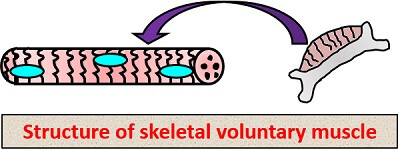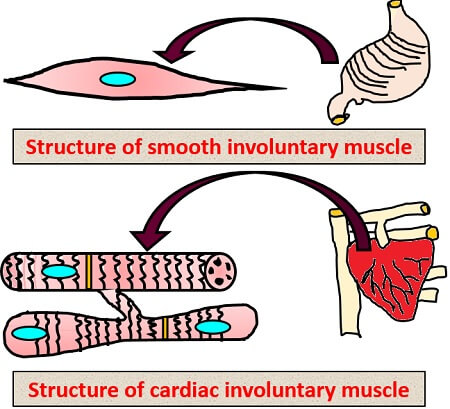The difference between voluntary and involuntary muscle is mainly due to their functional property. The functioning of a voluntary muscle is in our control or controlled by the somatic nervous system. Oppositely, the functioning of an involuntary muscle requires brain input, or it is controlled by the autonomic nervous system. Voluntary muscle and involuntary muscle are the muscle tissues that involve the functioning of the body and body parts. So, before proceeding to the concept of these two, we should know what is a muscle and what are its types?
What is muscle?
A muscle is fibrous and dense tissue, which consists of thin and elongated cells refers to “Muscle fibres“. These muscle fibres are the individual cells which are up to 30cm long. The muscle fibres consist of thin filaments or strands which refers to “Myofilaments”.
Types of muscles: Muscles are mainly of two kinds “Voluntary and involuntary”. Voluntary muscle subdivides into skeletal muscle, and involuntary muscle subdivides into smooth and cardiac muscle.
In this context, we will look into the key differences between the voluntary and involuntary muscle, along with the comparison chart.
Content: Voluntary Vs Involuntary Muscle
Comparison Chart
| Properties | Voluntary muscle | Involuntary muscle |
|---|---|---|
| Alternative name | Striated or skeletal muscle | Smooth or cardiac muscle |
| Nature | It is under one’s desire | It is not under one’s desire |
| Size | Long | Small |
| Shape | Cylindrical shape | Spindle or cylindrical shape |
| Branching | Unbranched | Branched |
| Nucleus | Multinucleated | Uni and bi-nucleated |
| Location | Attached to the bones | Attached to the wall of internal organs |
| Function | Movement of body and body organs | Movement of internal organs |
| Control | By somatic nervous system | By autonomic nervous system |
| Muscle contraction | Powerful and rapid | Rhythmic and slow |
| Muscle fatigueness | More | Less |
| Sarcolemma | Thick | Thin |
| Sarcomeres | Present | Absent |
| Intercalated disc | Absent | Present in cardiac muscle |
| Energy input | High | Low |
| Examples | Diaphragm, pharynx, abdominal wall etc. | Urogenital, alimentary, respiratory tract etc. |
Definition of Voluntary Muscle
These are the muscles which attach to the bone. The muscle action is in our control when to use them. “Somatic nervous system” controls its functioning, and therefore voluntary muscle is ‘Dependent‘. A skeletal muscle is a type of voluntary muscle, which appears as elongated and cylindrical muscle fibres.
Definition of Involuntary Muscle
These are the muscles which attach to the wall of internal organs, and the muscle action is not in our control. “Autonomic nervous system” controls its functioning and therefore it is ‘Independent‘. Smooth and cardiac muscle are the two types of involuntary muscle. Smooth muscles are small, spindle-shaped muscle fibres. Cardiac muscles are small, cylindrical and branched muscle fibres.
Structure
Before knowing the structural difference, we will first discuss the structural components that are found in the structure of both voluntary and involuntary muscle:
- Sarcolemma: It encases the muscle fibre and consists of the plasma and basement membrane.
- Nucleus: It can be multinucleated or uninucleated. A nucleus is generally oval and flat in shape. Its position can be central or peripheral.
- Sarcosomes: There are some other constituents present like enzymes, mitochondria, Golgi body, sarcoplasmic reticulum etc. besides nuclei.
- Myofibrils: These are long, thin and thread-like rods, which lies parallel to each other in the muscle fibre. Myofibrils are also termed as sarcostyles, which plays a vital role in the functioning of muscle contraction and relaxation.
- Striations: These are the ridges composed of light or dark bands in the muscle fibres.
- Branching: These acts as a bridge that attaches the muscle fibre by giving it a branching appearance.
Now coming onto structural difference, we should know that the skeletal muscles come under the category of a voluntary muscle and smooth and cardiac muscles come under the category of an involuntary muscle.

Therefore, a skeletal muscle is voluntary in function, whereas a smooth and cardiac muscle is involuntary in action. To know the structural difference between voluntary and involuntary muscle, a table is given below:
| Voluntary muscle | Involuntary muscle | ||
|---|---|---|---|
| Properties | Striated muscle | Smooth muscle | Cardiac muscle |
| Size | Long | Small | Small |
| Shape | Cylindrical with blunt end | Spindle shaped | Cylindrical shape with flat ends |
| Nucleus | Multinucleated | Uninucleated | Uni or bi-nucleated |
| Striations | Present | Absent | Present |
| Arrangement | Found in bundle | Found as sheet of visceral organs | Found as continuous network |
| Myofibrils/ Striations | Light and dark bands present | No bands or striations | Bands present |
| Sarcosomes | Numerous | Less in number | Numerous |
| Sarcolemma | Thick | Thin | Thin |
| Branching | Absent | Absent | Present |
| Mode of contraction | Rapid but for short time | Slow but for long time | Slow and rhythmic |

Characteristics Features of Skeletal Muscle
The characteristic structural features of voluntary skeletal muscles are:
- It is long, rod-like and cylindrical in shape.
- Striations present in this, due to which they are also termed as striated or striped muscle.
- Another identifying feature is that it has numerous nuclei that may be peripheral or central in position.

Characteristics Features of Smooth & Cardiac Muscle
The characteristic structural features of involuntary smooth and cardiac muscles are:
- Both smooth and cardiac muscle are small in size, whereas the shape of both differs. A former has a spindle-shape, and the latter possesses a cylindrical shape, respectively.
- Striations are absent in smooth muscle, whereas present in cardiac muscle.
- Smooth and cardiac muscle are uninucleated and sometimes bi-nucleated, which is generally centred in position.
- Another distinct feature is that the intercalated disc and branching is present in involuntary cardiac muscle, while absent in both smooth and skeletal muscle.
Key Differences Between Voluntary and Involuntary Muscle
- Skeletal muscle is an alternative name for a voluntary muscle, which means under one’s desire. And the alternative name of involuntary muscle is a smooth or cardiac muscle which is not under one’s desire.
- The size and shape of a voluntary muscle (skeletal) is long and cylindrical, respectively. In contrast, the size and shape of involuntary muscle, i.e. smooth and cardiac muscle is small and spindle or cylindrical in shape, respectively.
- In a voluntary muscle, branching is absent, while present in involuntary cardiac muscle and absent in involuntary smooth muscle.
- The skeletal muscle is found attached to the bones, whereas involuntary muscle is found attached to the wall of internal organs and helps in body movement and movement of internal organs, respectively.
- The somatic nervous system controls the muscle action of skeletal muscle, whereas the automatic nervous system controls the muscle action of an involuntary muscle.
- Skeletal muscle shows powerful and rapid muscle contraction but gets fatigued easily, whereas involuntary muscle shows rhythmic and slow muscle contraction and don’t get fatigued.
- Sarcomeres and thick sarcolemma are present in a voluntary muscle, whereas thin sarcolemma is present in the involuntary muscle without sarcomeres.
- An intercalated disc is absent in a skeletal muscle and present in involuntary cardiac muscle.
- The skeletal muscle requires high energy input for the muscle action, whereas involuntary muscle requires low energy input for the muscle action.
Conclusion
Therefore, we can conclude that both the voluntary and involuntary muscles are the types of muscle tissue, in which a former is dependent and the latter is independent. Thus, both perform different functions like the movement of the body or body organs, muscle contraction and relaxation, and also gives strength to the body to lift the things.